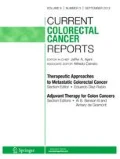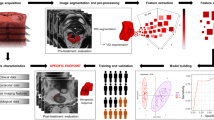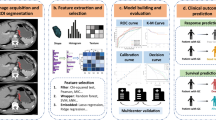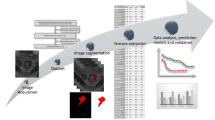Abstract
Purpose of Review
This literature review aims to gather the relevant works published on the topic of Radiomics in Rectal Cancer. Research on this topic has focused on finding predictors of rectal cancer staging and chemoradiation treatment response from medical images. The methods presented may, in principle, aid clinicians with the appropriate treatment planning options. Finding appropriate automatic tools to help in this task is very important, since rectal cancer has been considered one of the most challenging oncological pathologies in recent years.
Recent Findings
Radiomics is a class of methods based on the extraction of mineable, high-dimensional data/features from the routine, standard-of-care medical imaging. This data is then fed to machine learning algorithms, with the goal of automatically obtaining predictions regarding disease stage and therapeutic response.
Summary
The literature reviewed suggests that Radiomics will continue to be a part of the body of research in oncology in the upcoming years. However, and excluding very few studies, proper validation on the performance of the methods (mainly with external datasets) is still one of the main limitations of the field, which strongly limits their clinical applicability. Progress will only occur if the community opens itself to collaborate with different groups, as data availability and limited shareability continues to be the barrier for its development. Nowadays, Radiomics is used for nearly every type of cancer. In particular, for rectal cancer, the need for predicting treatment response will continue to demand and boost research in this field.
Similar content being viewed by others
References
Papers of particular interest, published recently, have been highlighted as: • Of importance •• Of major importance
• Bray F, Ferlay J, Soerjomataram I, Siegel R, Torre LA, Jemal A. Global Cancer Statistics 2018 : GLOBOCAN Estimates of Incidence and Mortality Worldwide for 36 Cancers in 185 Countries. CA Cancer J Clin. 2018;68:394–424 A global epidemiological platform that presents global cancer statistics to inform cancer control and cancer research.
Arnold M, Sierra MS, Laversanne M, Soerjomataram I, Jemal A, Bray F. Global patterns and trends in colorectal cancer incidence and mortality. Gut. 2017;66(4):683–91.
Dinapoli N, Casà C, Barbaro B, Chiloiro GV, Damiani A, Di Matteo M, Farchione A, Gambacorta MA, Gatta R, Lanzotti V, Masciocchi C, Valentini V. Radiomics for rectal cancer 2016;5(1):424–31.
Kapiteijn E, Marijnen CAM, Nagtegaal I, Putter H, Steup WH, Wiggers T, Rutten HJ, Pahlman L, Glimelius B, van Krieken J, Leer JW, van de Velde C, Dutch Colorectal Cancer Group. Preoperative radiotherapy combned with total mesorectal excision for resectable rectal cancer. N Engl J Med 2001;345(9):638–646.
Sauer R, Becker H, Hohenberger W, Rödel C, Wittekind C, Fietkau R, et al. Preoperative versus postoperative chemoradiotherapy for rectal Cancer. N Engl J Med. 2004;351(17):1731–40. Available from:. https://doi.org/10.1056/NEJMoa040694.
van de Velde CJH, Boelens PG, Borras JM, Coebergh J-W, Cervantes A, Blomqvist L, et al. EURECCA colorectal: multidisciplinary management: European consensus conference colon & rectum. Eur J Cancer. 2014;50(1):1.e1–1.e34 Available from: http://linkinghub.elsevier.com/retrieve/pii/S0959804913007806.
Ha HIL, Kim AY, Yu CS, Park SH, Ha HK. Locally advanced rectal cancer: diffusion-weighted MR tumour volumetry and the apparent diffusion coefficient for evaluating complete remission after preoperative chemoradiation therapy. Eur Radiol. 2013;23(12):3345–53.
Sebag-montefi D, Stephens RJ, Steele R, Monson J, Grieve R, Khanna S, et al. Preoperative radiotherapy versus selective postoperative chemoradiotherapy in patients with rectal cancer ( MRC CR07 and NCIC-CTG C016 ): a multicentre , randomised trial. Lancet. 2009;373:811–20.
Van Gijn W, CAM M, Nagtegaal ID, Kranenbarg EM, Putter H, Wiggers T, et al. Preoperative radiotherapy combined with total mesorectal excision for resectable rectal cancer : 12-year follow-up of the multicentre , randomised controlled TME trial. Lancet Oncol. 2011;12(6):575–82. Elsevier Ltd; Available from:. https://doi.org/10.1016/S1470-2045(11)70097-3.
Birgisson H, Påhlman L, Gunnarsson U, Glimelius B. Adverse effects of preoperative radiation therapy for rectal cancer : long-term follow-up of the Swedish rectal cancer trial. J Clin Oncol. 2005;23(34):8697–705.
Fernández-Martos C, Pericay C, Aparicio J, Salud A, Safont M, Massuti B, et al. Phase II , Randomized study of concomitant chemoradiotherapy followed by surgery and adjuvant capecitabine plus oxaliplatin ( CAPOX ) compared with induction CAPOX followed by concomitant chemoradiotherapy and surgery in magnetic resonance imaging – Defin. J Clin Oncol. 2010;28(5):859–65.
Stephens RJ, Thompson LC, Quirke P, Steele R, Grieve R, Couture J, et al. Impact of short-course preoperative radiotherapy for rectal cancer on patients’ quality of life: data from the Medical Research Council CR07 / National Cancer Institute of Canada clinical trials group C016 randomized clinical trial. J Clin Oncol. 2010;28(27):4233–9.
• Valk MJM, Van Der HDE, Bastiaannet E, Kranenbarg EM, Beets GL, Figueiredo NL, et al. Long-term outcomes of clinical complete responders after neoadjuvant treatment for rectal cancer in the International Watch & Wait Database (IWWD): an international multicentre registry study. Lancet. 2018;391:2537–45 The first large registry-based study on international watch-and-wait strategies for patients with rectal cancer.
•• Nie K, Shi L, Chen Q, Hu X, Jabbour SK, Yue N, et al. Rectal cancer : assessment of neoadjuvant chemoradiation outcome based on radiomics of multiparametric MRI. 2016;22(15):5256–64 First study to integrate anatomical, perfusion, and diffusion MRI using both volume-averaged and voxel-based quantitative analysis to predict pCR in rectal cancer.
Trebeschi S, Van Griethuysen JJM, Lambregts DMJ, Lahaye MJ, Parmer C, Bakers FCH, et al. Deep learning for fully-automated localization and segmentation of rectal cancer on multiparametric MR. Sci Rep Springer US. 2017;7(1):1–9.
Maas M, Lambregts DMJ, Nelemans PJ, Heijnen LA, Martens MH, Leijtens JWA, et al. Assessment of clinical complete response after chemoradiation for rectal cancer with digital rectal examination, endoscopy, and MRI: selection for organ-saving treatment. Ann Surg Oncol. 2015;22:3873–80.
Trattnig S. The shift in paradigm to precision medicine in imaging: international initiatives for the promotion of imaging biomarkers. In: Martí-Bonmatí L, Alberich-Bayarri A, editors. Imaging Biomarkers. Cham: Springer International Publishing; 2017. p. 1–7. Available from: http://link.springer.com/10.1007/978-3-319-43504-6_1.
Harrell F. Regression modeling strategies. New York, NY: Springer New York; 2001. (Springer Series in Statistics). Available from: http://link.springer.com/10.1007/978-1-4757-3462-1.
Diehn M, Nardini C, Wang DS, McGovern S, Jayaraman M, Liang Y, et al. Identification of noninvasive imaging surrogates for brain tumor gene-expression modules. Proc Natl Acad Sci. 2008;105(13):5213–8. Available from:. https://doi.org/10.1073/pnas.0801279105.
Ganeshan B, Panayiotou E, Burnand K, Dizdarevic S, Miles K. Tumour heterogeneity in non-small cell lung carcinoma assessed by CT texture analysis: a potential marker of survival. Eur Radiol. 2012;22(4):796–802.
Lambin P, Van Stiphout RGPM, Starmans MHW, Rios-Velazquez E, Nalbantov G, Aerts HJWL, et al. Predicting outcomes in radiation oncology-multifactorial decision support systems. Nat Rev Clin Oncol. 2013;10(1):27–40.
• Aerts HJWL. The potential of radiomic-based phenotyping in precision medicine a review. JAMA Oncol. 2016;2(12):1636–42 Important review that highlights the promise ofradiomicsfor precision medicine.
Aerts HJWL, Velazquez ER, Leijenaar RTH, Parmar C, Grossmann P, Cavalho S, Bussink J, Monshouwer R, Haibe-Kains B, Rietveld D, Hoebers F, Rietbergen MM, Leemans CR, Dekker A, Quackenbush J, Gillies RJ, Lambin P. Decoding tumour phenotype by noninvasive imaging using a quantitative radiomics approach. Nat Commun 2014;5.
•• Sun Y, Hu P, Wang J, Shen L, Xia F, Qing G, Hu W, Zhang Z. Radiomic features of pretreatment MRI could identify T stage in patients with rectal cancer : preliminary findings. J Magn Reson Imaging. 2018; Study determining if radiomic features extracted from T2-weighted imaging (T2WI) can identify pathological features in rectal cancer.
Liu L, Liu Y, Xu L, Li Z, Lv H, Dong N, Li W, Yang Z, Wang Z, Jin E. Application of texture analysis based on apparent diffusion coefficient maps in discriminating different stages of rectal cancer. J Magn Reson Imaging 2016.
Cui C, Cai H, Liu L, Li L, Tian H, Li L. Quantitative analysis and prediction of regional lymph node status in rectal cancer based on computed tomography imaging. Eur Soc Radiol. 2011;21:2318–25.
•• Bibault J, Giraud P, Housset M, Durdux C, Taieb J, Berger A, et al. Deep learning and radiomics predict complete response after neo-adjuvant chemoradiation for locally advanced rectal cancer. Sci Rep. 2018;8:1–8 A proof-of-concept study, stating that combining clinical and radiomics features is feasible and can accurately predict patients who will have a complete pathological response aſter neo-adjuvant chemoradiotherapy.
Chee CG, Kim YH, Lee KH, Lee YJ, Park JH, Lee HS, Ahn S, Kim B. CT texture analysis in patients with locally advanced rectal cancer treated with neoadjuvant chemoradiotherapy : a potential imaging biomarker for treatment response and prognosis. PLoS One 2017;1–12.
•• Liu Z, Zhang X, Shi Y, Wang L, Zhu H, Tang Z, et al. Radiomics analysis for evaluation of pathological complete response to Neoadjuvant Chemoradiotherapy in locally advanced rectal Cancer. Clin Cancer Res. 2017;(16):7253–63 Study that uses pre- and post-treatment MRI data to build aradiomicsmodel that predicts pCR in patients with LARC.
•• Cusumano D, Dinapoli N, Boldrini L, Chiloiro G, Gatta R, Masciocchi C. Fractal - based radiomic approach to predict complete pathological response after chemo - radiotherapy in rectal cancer. Radiol Med. 2018;123(4):286–95. https://doi.org/10.1007/s11547-017-0838-3Relevant study that uses MR images to predict pCR after CRT, in which the model is validated by an independent dataset.
•• Horvat N, Veeraraghavan H, Khan M, Blazic I, Zheng J, Capanu M, et al. MR imaging of rectal cancer: radiomics analysis to assess treatment response after Neoadjuvant therapy. Radiology. 2018;287(3):833–43 Study shows thatradiomicmeasures shows better classification performance compared to qualitative assessment for diagnosing pCR in patients with locally advanced rectal cancer.
Meng Y, Zhang C, Zou S, Zhao X, Xu K, Zhang H, et al. MRI texture analysis in predicting treatment response to neoadjuvant chemoradiotherapy in rectal cancer. Oncotarget. 2018;9(15):11999–2008.
van Heeswijk MM, Lambregts DMJ, van Griethuysen JJM, Oei S, Rao S-X, de Graaff CAM, et al. Automated and semi-automated segmentation of rectal tumpr volumes on diffusion-weighted MRI: can it replace manual volumetry? Int J Radiat Oncol Biol Phys. 2016. Elsevier Ltd 2015; Available from:. https://doi.org/10.1016/j.ijrobp.2015.12.017.
Kamnitsas K, Ledig C, Newcombe VFJ, Simpson JP, Kane AD, Menon DK, et al. Efficient multi-scale 3D CNN with fully connected CRF for accurate brain lesion segmentation. Med Image Anal. 2017;36:61–78. Elsevier B.V.; Available from:. https://doi.org/10.1016/j.media.2016.10.004.
Razzak MI, Naz S, Zaib A. Deep learning for medical image processing: overview, challenges and future. CoRR. 2017;22:1–30 Available from: http://arxiv.org/abs/1704.06825.
Gatta R, Vallati M, Dinapoli N, Masciocchi C, Lenkowicz J, Cusumano D, et al. Towards a modular decision support system for radiomics: a case study on rectal cancer. Artif Intell Med. 2018. Elsevier; Available from:. https://doi.org/10.1016/j.artmed.2018.09.003.
Summers RM. Texture analysis in radiology: does the emperor have no clothes ? Abdom Radiol. 2017;42(2):342–5 Relevant review on texture analysis in radiology.
Funding
This work was partially supported by national Portuguese funds through FCT (Fundação para a Ciência e a Tecnologia) under project PTDC/CCI-INF/29168/2017 (BINDER).
Author information
Authors and Affiliations
Corresponding author
Ethics declarations
Conflict of Interest
The authors declare that they have no conflict of interest.
Human and Animal Rights and Informed Consent
This article does not contain any studies with human or animal subjects performed by any of the authors.
Additional information
Publisher’s Note
Springer Nature remains neutral with regard to jurisdictional claims in published maps and institutional affiliations.
This article is part of the Topical Collection on Diagnostic and Interventional Radiology Innovations in Colorectal Cancer
Rights and permissions
About this article
Cite this article
Moreira, J.M., Santiago, I., Santinha, J. et al. Challenges and Promises of Radiomics for Rectal Cancer. Curr Colorectal Cancer Rep 15, 175–180 (2019). https://doi.org/10.1007/s11888-019-00446-y
Published:
Issue Date:
DOI: https://doi.org/10.1007/s11888-019-00446-y




